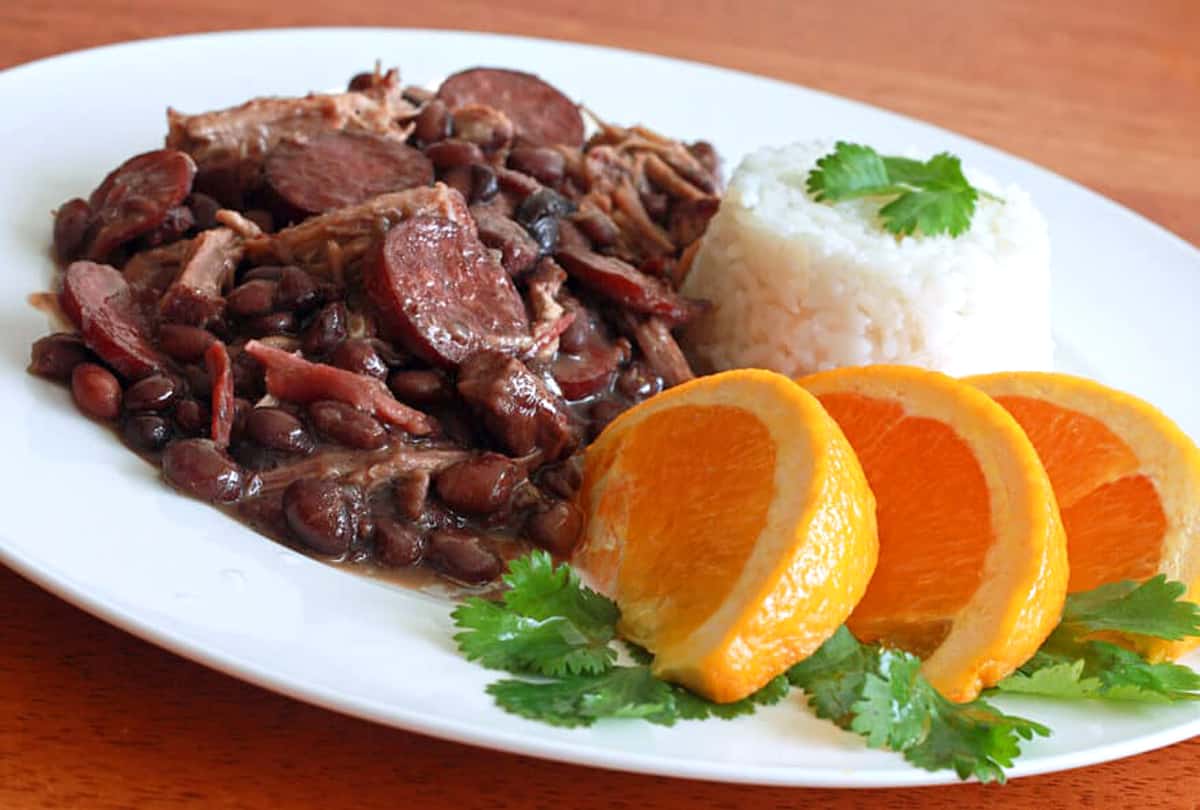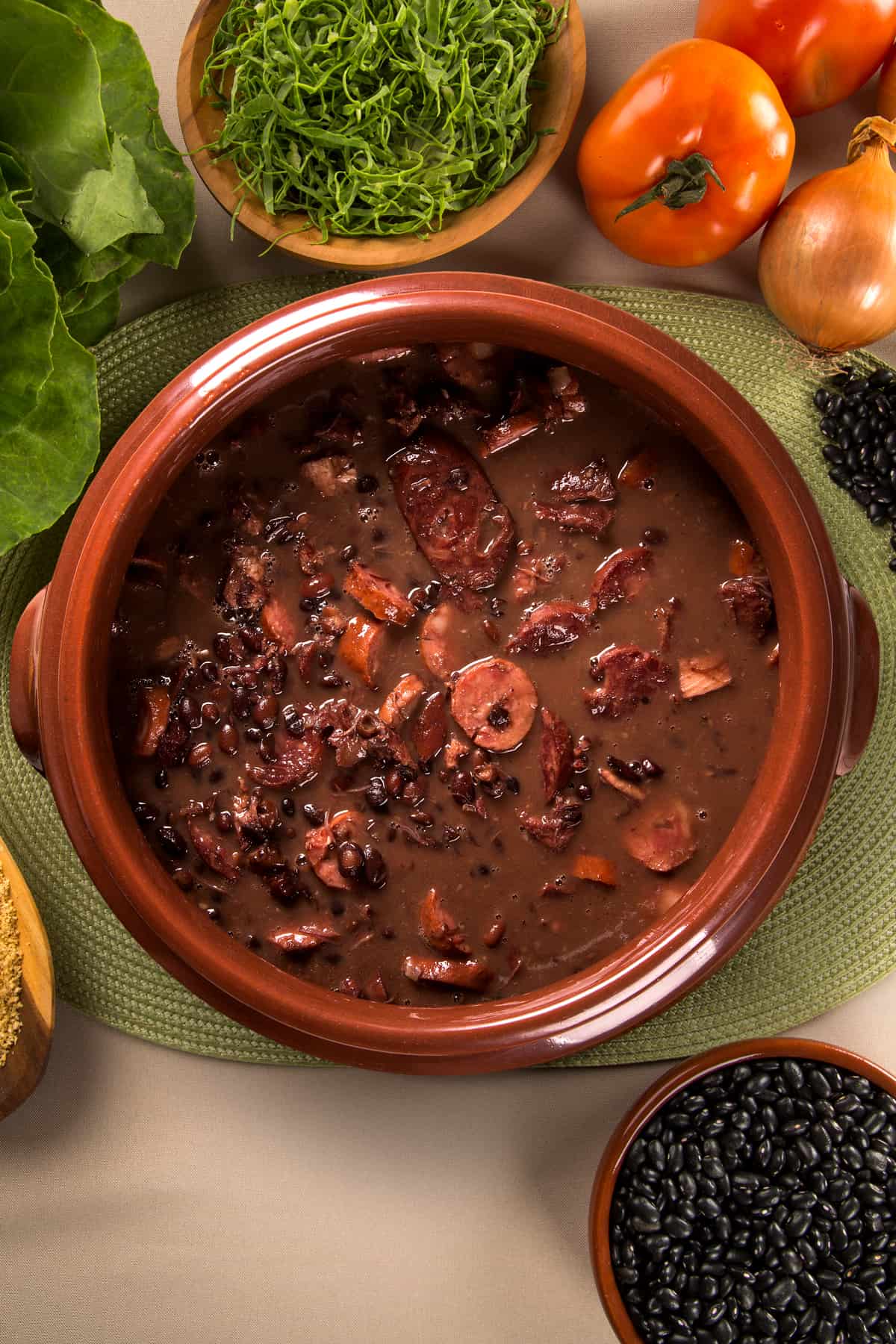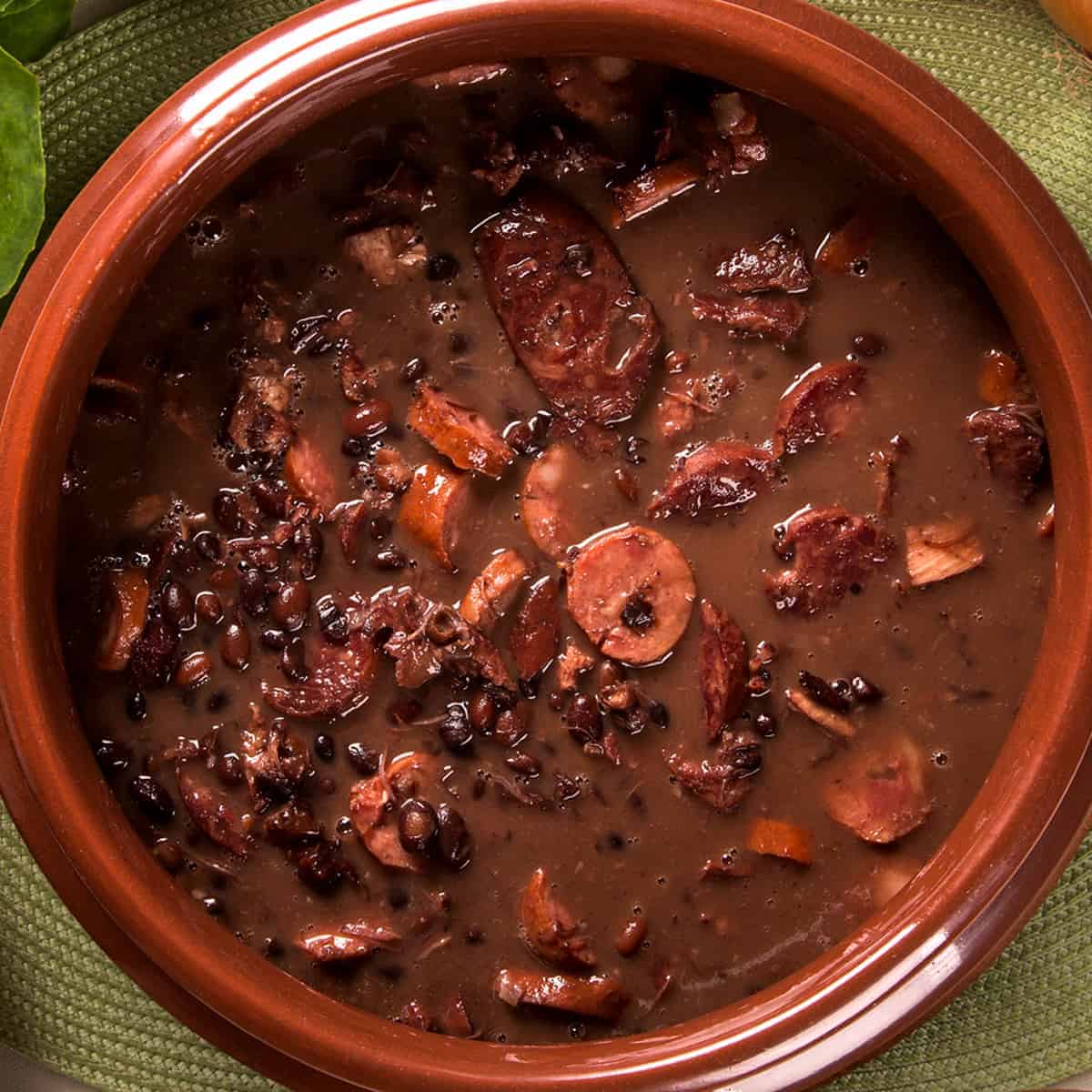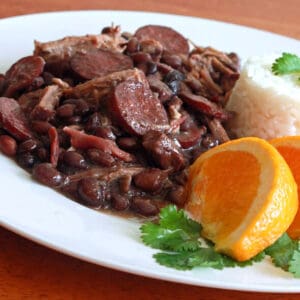Feijoada (Brazilian Black Bean Stew)
This post may contain affiliate links. See my disclosure policy.
The famous slow-cooked, flavor-packed, umami-rich black bean stew from Brazil, this authentic Feijoada recipe is easy to make and is an absolute feast for the taste buds! Incredibly delicious, it’s no wonder this ultimate comfort dish is the national dish of Brazil!

This feijoada is one of the very first recipes I published on my blog back in 2013 and it has remained a family favorite ever since. The flavors are rich and so delicious and they improve over time, making this a perfect make-ahead dish!
What is Feijoada?
Feijoada (pronounced fay-jwa-da) is the National Dish of Brazil and what a dish it is! In some ways you could say it’s the Brazilian version of French cassoulet in that it’s a bean dish featuring several kinds of meats. Whereas cassoulet is made with white beans and typically includes pork sausages, goose, duck, and sometimes mutton, Feijoada is made with black beans and features a variety of pork and beef products in salted, smoked, and cured form. The interplay of these meat flavors in feijoada makes it an exciting feast for the taste buds.
Feijoada is most commonly served with sliced oranges and rice, though fried bananas and chilies are also common accompaniments. Feijoada is made virtually everywhere in Brazil, from the humblest home to the most sophisticated restaurant in Rio. Reflective of its popularity, some restaurants even feature a “Feijoada Day.”
There are countless versions of feijoada with each home cook and restaurant chef using their own favorite combination of ingredients. But a hallmark of feijoada is that it combines a variety meat products: Fresh, cured, salted, and smoked – all thrown in together in one big pot of savory goodness. My version uses pork roast (slowly cooked in all the juices and later shredded), bacon, spicy sausage, smoked sausage, and smoked ham hocks. (If you’re an avid DIY’er like me, check out my post on how to make your own smoked ham hocks!) All of this is slow-cooked for a couple of hours with black beans and seasonings. You’ll hardly be able to resist the mouthwatering smell emanating from your kitchen…and just wait until you taste it!

Where Did Feijoada Originate?
Feijoada is believed to date back to the 16th century when it was made using the cheapest cuts of pork such as ears, snout, feet and belly. There is more than one theory as to origin of this dish, one of them linking it to the 1.3 million enslaved people brought from Africa to work the sugarcane plantations of Brazil. Beans were a staple the Africans were already familiar with from their homeland and when they were given the leftover scraps of pork they used their creativity to make a meal of it that would eventually become part of the country’s core identify.
Others note the Portuguese influence in the stew. Brazil was under the rule of the Portuguese Empire until it won its independence in 1822, and so Brazilian cooking in general has a lot of Portuguese influence. Perhaps its origin stems from a combination of the two theories.
This Brazilian black bean stew is comfort food at its best. I was first introduced to it by a Brazilian family in Germany and I haven’t been able to get enough of it since. The slow-cooked, umami-rich flavor of this meat and black bean stew is incredible. The sweet and refreshing citrus that accompanies it provides a pleasing contrast and offers a quick cleansing of the palate before second servings of the stew are requested, which they inevitably will be.
Feijoada Recipe
Feijoada is easy to make and if you’re patient enough to wait until the next day to eat it the flavor is even better!
- Soak the beans in a large bowl of water overnight.
- In a large Dutch oven or heavy duty pot, heat the oil over medium-high heat and brown the pork shoulder until generously browned on each side. Remove the pork and set aside. In the same pan, add the bacon and cook until slightly crispy (for the best flavor leave the grease but you can drain some of it if you prefer). Add the onions and cook the onions until soft and translucent, about 5 minutes. Add the garlic and cook for another minute. Add the crumbled Italian sausage and smoked sausage and cook until the crumbled sausage is no longer pink.
- Return the pork roast to the pot along with the smoked ham hock. Drain, rinse, and add the black beans to the pot. Add the bay leaves, black pepper, and beef bouillon base/cubes. Cover the contents of the pot with water until the meat is just barely covered (about 2 quarts). Bring it to a boil, reduce the heat to low, cover and let simmer for 2 hours, making sure the beans are soft. About 1 1/2 hours into the cooking time, if using whole pork roast, remove and either shred or cut it into chunks, and return to the pot. Do the same with the meat on the smoked ham hock.
- If the feijoada is too liquidy, uncover the pot and continue to cook for another 20 minutes or so to allow some of the liquid to evaporate. Add more salt to taste as needed. Add some hot sauce according heat preference. Discard the bay leaves.
- Serve with rice and fresh orange slices.
Enjoy!

For more delicious stews from around the world be sure to try my:
- Doro Wat (Ethiopian Chicken Stew)
- Sega Wat (Ethiopian Beef Stew)
- Irish Guinness Stew
- Hungarian Goulash
- Plasas (West African Peanut Chicken Stew)
- Pichelsteiner (Bavarian Stew)
- Pörkolt (Hungarian Beef and Onion Stew)
- Domoda (Gambian Peanut Stew)
- Hachee (Dutch Beef and Onion Stew)
- Kalops (Swedish Beef Stew)
- French Beef Bourgignon
- Mexican Pozole Rojo
Save This Recipe

Feijoada (Brazilian Black Bean Stew)
Ingredients
- 1 pound dried black beans
- 3 Tbsp cooking oil (I use avocado oil as it has a high smoke point but you can also use canola)
- 1 pound pork shoulder , left whole and shredded at the end of cooking or cut into chunks
- 2 large onions , sliced
- 5 cloves garlic , minced
- 1/2 pound fresh Italian or other spicy sausage , casings removed and crumbled
- 1/2 pound smoked sausage , such as linguica or kielbasa, sliced into rounds
- 1/2 pound thick sliced bacon , cut into small pieces
- 1 smoked ham hock
- 4 bay leaves
- water
- 1 tablespoon beef bouillon base (e.g., Better Than Bouillon)
- 1/2 teaspoon black pepper
- salt to taste
- hot sauce , according to heat preference
- orange , washed and cut into slices
Instructions
- Soak the beans in a large bowl of water overnight.
- In a large Dutch oven or heavy duty pot, heat the oil over medium-high heat and brown the pork shoulder until generously browned on each side. Remove the pork and set aside. In the same pan, add the bacon and cook until slightly crispy (for the best flavor leave the grease but you can drain some of it if you prefer). Add the onions and cook the onions until soft and translucent, about 5 minutes. Add the garlic and cook for another minute. Add the crumbled Italian sausage and smoked sausage and cook until the crumbled sausage is no longer pink.
- Return the pork roast to the pot along with the smoked ham hock. Drain, rinse, and add the black beans to the pot. Add the bay leaves, black pepper, and beef bouillon base/cubes. Cover the contents of the pot with water until the meat is just barely covered (about 2 quarts). Bring it to a boil, reduce the heat to low, cover and let simmer for 2 hours, making sure the beans are soft. About 1 1/2 hours into the cooking time, if using whole pork roast, remove and either shred or cut it into chunks, and return to the pot. Do the same with the meat on the smoked ham hock.If the feijoada is too liquidy, uncover the pot and continue to cook for another 20 minutes or so to allow some of the liquid to evaporate. Add more salt to taste as needed. Add some hot sauce according heat preference. Discard the bay leaves.Serve with rice and the fresh orange slices.
Nutrition
Originally published on The Daring Gourmet January 9, 2013



















Fantastic!!! used a meat arrangement from a local Brazilian market. Just can’t bring myself to use the pig ear but replaced w portuguese chourico that I grew up with and we can’t get enough!!
That’s awesome, Theresa!! I’m so thrilled that you enjoyed it and I really appreciate the feedback, thank you! <3
This was absolutely delicious, a new family favorite!
Thank you so much, Sonya, I’m so glad it was a family hit!
This is not original Brazilian feijoada, as a Brazilian and feijoa is my favourite dish, i would make with different sausages and pork meat, you would see how delicious it is when you don’t use Italian sausage (taste bad) .
I made this exactly like the recipe stated and it was AMAZING! It is going to be a staple in our house now! Thank you for taking me on a trip to Brazil!
I’m so glad it was a family hit, Amy, thank you very much! <3
Can you use canned black beans?
Hi Neera, yes you can use canned black beans. Follow the same cooking time for the recipe but add the beans in after the first hour.
For over 30 years, I have been making this national dish of Brazil for my catering clients. Jan Parker Lisi, a Pam American flight attendant traveled there often and stayed with a family who shared their recipe. I present this with smoky and grilled marinated pork chops and serve it on a big platter. Rice is placed underneath, then the chops in the center. After that Brazilian collard greens cooked in OO, garlic and lemon juice, S & P. A fresh salsa is then circled around that. The final touch are slices of oranges. This is a beautiful presentation and I get raves down here in the Triangle area of NC. Cheers, Zacki’s Culinary Creations.
thanks for sharing this great dish. this looks so delicious and I’m very curious about it’s taste.
After reading the different mixtures of meat historically used in this stew I made adjustments as I don’t eat pork. I replaced the ham hock with a large oxtail, I used turkey ham for the bacon, lamb shoulder to replace pork shoulder. I make my own Italian sausage using turkey. It was very interesting, smoky, complexed and hearty. Thank you for a taste of Brazil.
Thank you for the feedback, Alfredia. I’m happy you were able to adapt the recipe to your needs and that you enjoyed the outcome!
The author did not include an few essencial accompanyment to feijoada: rolled collard greens finely cut sofrito. Also missed the toasted manioc flour called farofa, dried beef and portuguese paio sausage, as italian sausage and kielbasa are not part of the original.
This recipe looks fabulous! Do you have have any modifications for slow cooker or pressure cooker?
Thank you
I’m a pressure cooker lover. I had great success with this recipe. I followed the ingredient list precisely except I used 1 seeded, minced jalapeno pepper added with garlic instead of hot sauce. I did not soak my beans. Cooked this way in a pressure cooker, some beans burst and contribute to a thicker luscious gravy. 45 minutes, quick release. I used a total of 6 cups of water (far less than the 2 quarts recommended for soaked beans). Even so, I thought the stew was a bit watery. While it reduced for another 10 minutes on the stove, I shredded my pork and added a small handful of meat from the ham hock. OMG! This is fantastic. I want to make it again tomorrow and freeze some for later.
Wonderful, Brent! I’m so glad you enjoyed it and appreciate the feedback and details about using a pressure cooker, thank you!
Just a follow-up. The Kielbasa cooked in the pressure cooker had a soft texture. Next time I will brown the slices first. The jalapeno didn’t add much. It was much better with hot sauce as originally recommended.
Finding you and your fabulous site is a grand find! Everything here is top notch and your photography is as good as the best food photographers produce. Take it from a seasoned pro. Your recipes are great, easy to follow and enticing to follow. Take it from a non pro schooled cook. Everything I found here speaks very highly of the great person behind it. I hope and wish, your entire life is as juicy, flavored and comforting as your site. Thanks!!!
Warmest regards.
Isis Mc
Thank you so much for the kind words and generous compliments, Isis, I’m glad you found our site!
I already made this one. It was very very good!!!. Thanks :)
So glad you liked it!
Oh my…I died and went to heaven…now have access to all your fabulous recipes!!!wow …cant wait, dont know where to start!!!
Thank you, Pam!